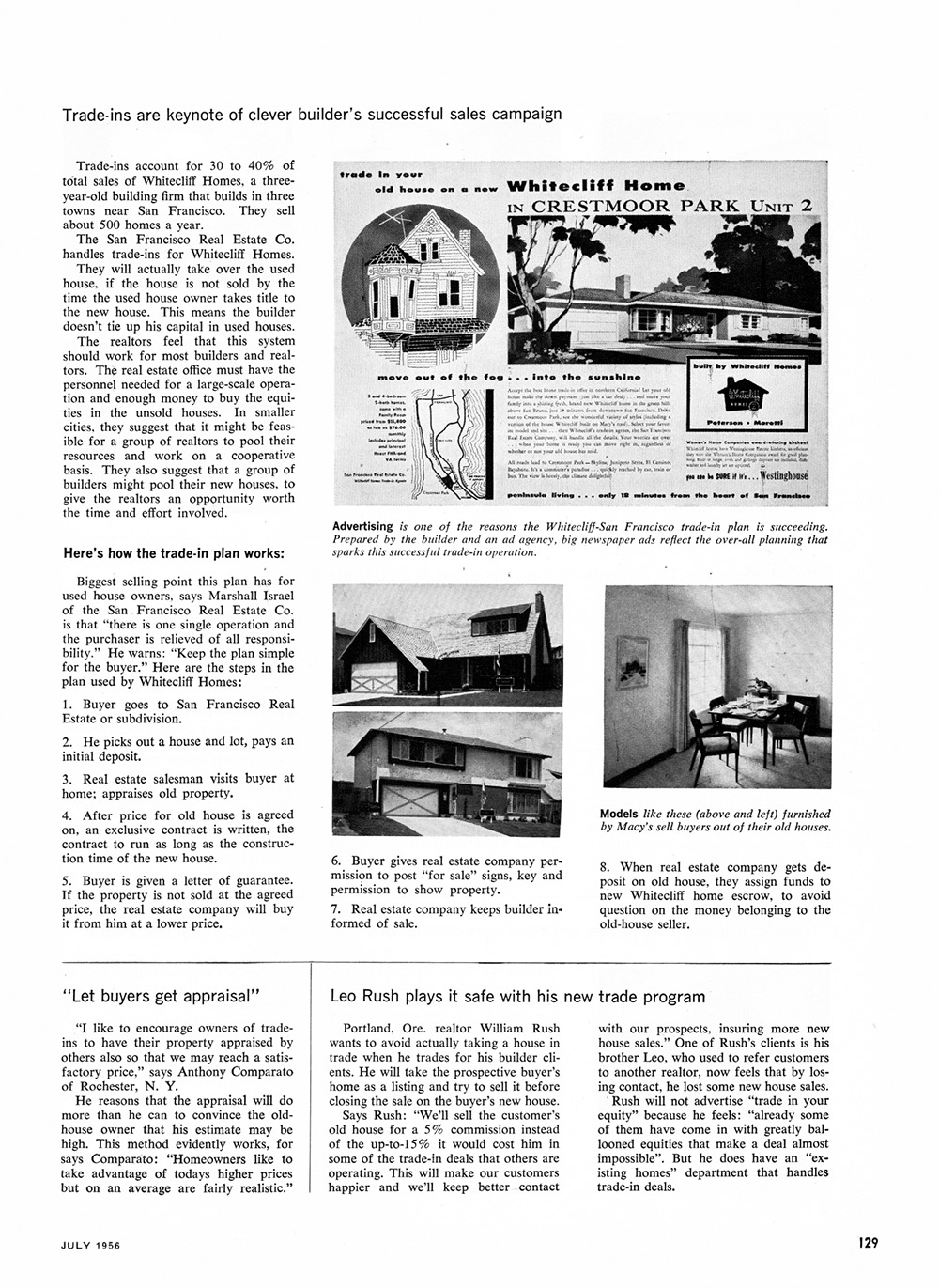


Trade-ins are keynote of clever builder's successful sales campaign
Trade-ins account for 30 to 40% of total sales of Whitecliff Homes, a three-year-old building firm that builds in three towns near San Francisco. They sell about 500 homes a year.
The San Francisco Real Estate Co. handles trade-ins for Whitecliff Homes.
They will actually take over the used house, if the house is not sold by the time the used house owner takes title to the new house. This means the builder doesn't tie up his capital in used houses.
The realtors feel that this system should work for most builders and realtors. The real estate office must have the personnel needed for a large-scale operation and enough money to buy the equities in the unsold houses. In smaller cities, they suggest that it might be feasible for a group of realtors to pool their resources and work on a cooperative basis. They also suggest that a group of builders might pool their new houses, to give the realtors an opportunity worth the time and effort involved.
Here's how the trade-in plan works:
In your
old house
new Whitecliff Home
in CRESTMOOR PARK Unit 2
move out of the fog • • • into the sunshine
tat N*t So┬½iŌģ£ ItŌģø┬Į vft oŌģøn la owtfcwo CxiiŌģ×i┬½u>"ś Ut your ol-J hcwi* nAt ifc* Java ptynttitt ';tM wfc┬½ * cm tlnl: . . . tail aevt ftvi (amity- into * MlkrŌģ£ (rub, hrtftd nor Ōģ× b-itviiif Iicmht in t&t ┬Żft*n MŌģø *bo*r SUs Bruno. ju>< J* ┬½nfl┬½┬½n frŌģøŌģøŌģ£ ifott nJouT. sUo ruiuŌģøa. DrŌģØc ┬½w to Civtnuoor Pvi. *┬½ Uw ┬╗┬╗Ōģ£4rrfŌģøl vmŌģøŌģ£y uS wyŌģø┬╗ (iftiWŌģøŌģØ ┬╗ uimw ci iU bou┬½ Ōģ× fcurdŌģø Ōģøuit o┬½ M┬╗iy*┬╗ toaiy. ŌģØŌģøvt y┬½ur Ōģø*v>-ik fKŌģøtii tad ┬╗┬½• . IŌģ×MO Ōģ£'h┬½┬½:iir> ttuk-tt ib< Ōģøa I'laoitn-o
Beat lettt* CŌģøfnfuny. ┬½ U handle aJl'ibe 4ruiU. Your wcerir* arc o┬½┬½f . , ┬½Ōģøi your !<uiq┬½ >i (ttjf you ctR 0┬╗-<┬╗ tight in. ┬╗Ōģølt\IUŌģø┬╗ Of ŌģØhŌģøArc or not your otvJ bouw ivu inU.
All roaŌģø lead u> CioURoor Ptiit Skyba*. jiiaipcvo Stir*. P) CŌģøouŌģ×o, IWjifeoK. ill ┬╗ ŌģøORBMMer'* puu┬Įt . . qu-vŌģ£ir rrttfcrd by car, tiara or but. The view it lorriy. due Ōģøliaare dv.'ŌģølnlŌģøi:
hhthmM
U'fc-Ōģø.xf U-r.n t*>i Ve/.'.Ōģ£u ix lŌģøŌģøf* to i(uw
(brr Ōģ£:: (Ōģø VtvŌģøl'Ōģ£ H.:r:r C.RfW* rtsd fer gW yTŌģ£Jr KwŌģ£ tail -x. Ōģ£,Ōģ£ŌģØ itftttt m ŌģøvŌģøŌģøi <Ōģøt-
┬╗Ōģø>P ŌģøŌģøŌģ×ft) yt in Ōģ£jŌģ×Ōģ£mV Ōģø.
t┬½ u sum ii in... Ōģ£i'sŌģøboiise
far?rtinsula living ... only 18 mlnulv
Advertising is one of the reasons the Whitecliff-San Francisco trade-in plan is succeeding. Prepared by the builder and an ad agency, big newspaper ads reflect the over-all planning that sparks this successful trade-in operation.
Biggest selling point this plan has for used house owners, says Marshall Israel of the San Francisco Real Estate Co. is that "there is one single operation and the purchaser is relieved of all responsibility."Ø He warns: "Keep the plan simple for the buyer."Ø Here are the steps in the plan used by Whitecliff Homes:
1. Buyer goes to San Francisco Real Estate or subdivision.
2. He picks out a house and lot, pays an initial deposit.
3. Real estate salesman visits buyer at home; appraises old property.
4. After price for old house is agreed on, an exclusive contract is written, the contract to run as long as the construction time of the new house.
5. Buyer is given a letter of guarantee. If the property is not sold at the agreed price, the real estate company will buy it from him at a lower price.
6. Buyer gives real estate company permission to post "for sale"Ø signs, key and permission to show property.
7. Real estate company keeps builder informed of sale.
Models like these (above and left) furnished by Macy's sell buyers out of their old houses.
8. When real estate company gets deposit on old house, they assign funds to new Whitecliff home escrow, to avoid question on the money belonging to the old-house seller.
Leo Rush plays it safe with his new trade program
"Let buyers get appraisal"Ø
"I like to encourage owners of trade-ins to have their property appraised by others also so that we may reach a satisfactory price,"Ø says Anthony Comparato of Rochester, N. Y.
He reasons that the appraisal will do more than he can to convince the old-house owner that his estimate may be high. This method evidently works, for says Comparato: "Homeowners like to take advantage of todays higher prices but on an average are fairly realistic."Ø
Portland, Ore. realtor William Rush wants to avoid actually taking a house in trade when he trades for his builder clients. He will take the prospective buyer's home as a listing and try to sell it before closing the sale on the buyer's new house.
Says Rush: "We'll sell the customer's old house for a 5% commission instead of the up-to-15% it would cost him in some of the trade-in deals that others are operating. This will make our customers happier and we'll keep better contact
with our prospects, insuring more new house sales."Ø One of Rush's clients is his brother Leo, who used to refer customers to another realtor, now feels that by losing contact, he lost some new house sales.
Rush will not advertise "trade in your equity"Ø because he feels: "already some of them have come in with greatly ballooned equities that make a deal almost impossible"Ø. But he does have an "existing home-Ø department that handles trade-in deals.